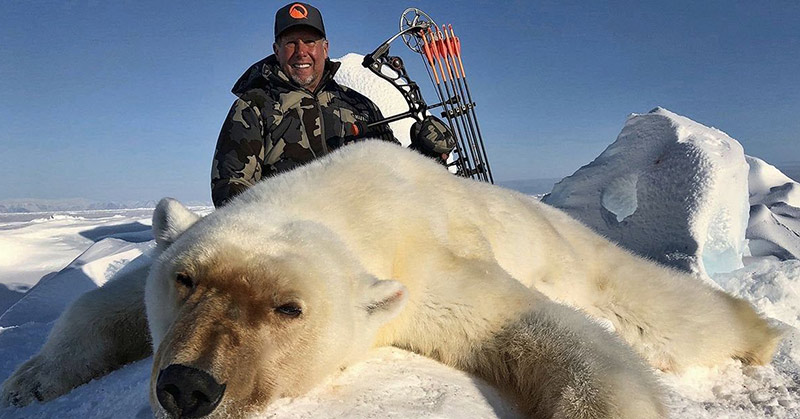Polar bears are an iconic creature, their white fur, and giant size is unmistakable. But humans have been taking these creatures for granted for far too long. To say that the polar bear is in trouble is a bit of an understatement. According to the IUCN red list, polar bears are considered vulnerable [1]. In Canada, they are of “special concern“[2]. They are considered threatened in the United States. [3] Most recognize that these bears are having a tough time.
Recently, the United States announced that it will not pursue an international ban on the commercial trade of polar bear hides [4]. The reception of this decision has been mixed. Native Inuit organizations have applauded the decision as one that will protect their sovereign indigenous rights to hunt polar bears for their meat and pelts, the latter of which is valued at almost $80,000 USD. But others are concerned that the rate of trophy hunting is unsustainable and must be banned in order to protect the species.
According to Ole Liodden, an award-winning wildlife photographer and conservationist, the increasing pressure on polar bears in conjunction with climate change is a recipe for extinction for the species, and that the practice of hunting the animals must come to an end if we are to save them from extinction.
“We have to stop trophy hunting and the commercial skin trade,” Liodden said in an interview with Mirror. [5] “It is the only way polar bears have a chance of survival in a future with global warming.”
It’s estimated that some 50,000 polar bears have been killed since the 1960s with nearly one-fifth of those bears being hunted in the 9-year span from 2007 to 2016. According to the IUCN, there are likely only 20,000 to 25,000 left living in the wild [6]. Some steps have been taken to restrict the practice of hunting polar bears. Ship-based and aerial hunting of the bears has been banned by an international agreement since the 1970s. Liodden feels this is not sufficient for saving the species.
To Liodden, it all boils down to sustainability and the species’ ability to reproduce quickly enough, coupled with the impact of climate change.
“The polar bear is one of the most exclusive species for trophy hunters to pursue. But it is the mammal species least suitable because of low cub survival, low reproduction rate, and climate change.”
“Although a warmer climate may largely determine the future distribution of polar bears, the vast majority of population reductions over the past 30 years are attributable to unsustainable hunting.”
For centuries, indigenous tribes in what is now Canada and the United States have hunted polar bears, but in the 1940s, when trophy hunting of the animals began, the rate at which the animals were killed exploded. Wealthy trophy hunters took advantage of the now-banned practices of aerial hunting and ship-based hunting to easily bag themselves a mighty polar bear.
Read: Bald Eagles Keep Dying Because of Lead Poisoning And No One’s Talking About It
Today, Canada remains the only country on Earth where hunting polar bears is not banned. Some Inuit tribal leaders stand with conservationists like Liodden in their opposition to hunting the animals, but the Canadian government encourages them to engage in the legal practice of hunting polar bears and even goes as far as to encourage them to act as guides for trophy hunters.
According to the Daily Mirror, an investigation has “uncovered a host of firms offering hunts in the Arctic Circle marketed as “the most memorable” trophy collectors would ever find.”
Experts are warning that polar bear populations could be cut in half by the middle of the century with the current rate of global warming and that given such a steep decline is possible, trophy hunting of polar bears needs to be completely banned.
Read: Rainbow Snake Seen In Florida’s Ocala National Forest For First Time since 1969
“Why the hell are we allowing trophy hunters to kill them for fun?” asked Eduardo Goncalves, the founder of the Campaign to Ban Trophy Hunting in an interview with Mirror.
“Trophy hunters kill the biggest animals, removing the genes needed to help it survive global warming. It’s another reason why trophy hunting is a crime against nature.”
According to Polar Bears International, past population management strategies have been sufficient for guaranteeing the continued survival of polar bears. But the welfare of the animals is under threat by climate change. From their website [7]:
“When habitats were stable a sustainable harvest could be calculated and the number of hunter tags kept within that sustainable harvest. Unfortunately, polar bear habitat is no longer stable. Polar bears depend on the sea-ice surface to catch their seal prey, and global warming means progressively less sea ice on which they can hunt. Ultimately, all polar bears will see their habitats literally melting under their feet unless we act to curb greenhouse gas emissions. Then, there will be no sustainable harvest anywhere.”
Still, they believe that some polar bear populations are stable enough for hunts to continue.
“Those that are not yet seeing the negative effects of habitat loss can provide a limited harvest for some time to come. Maintaining these harvests in the longer term depends on reducing the rise in greenhouse gas concentrations. But for now, some populations may still be safely hunted.”
But that optimism isn’t shared by many. “It doesn’t look like they’re going to be around for very much longer in most populations,” said Péter Molnár, a researcher at the University of Toronto Scarborough in an interview with National Geographic. [8]
“We have very strong evidence that these declines will just get worse as the climate changes. Unless we’re turning things around on that front, it’s a pretty grim and predetermined outcome.”
Keep Reading: Blue Whales Have ‘Unprecedented’ Bounce Back From Brink Of Extinction
- https://www.iucnredlist.org/species/22823/14871490
- https://www.canada.ca/en/services/environment/wildlife-plants-species/wildlife-habitat-conservation/conservation-polar-bears.html
- https://www.fws.gov/alaska/pages/marine-mammals/polar-bear/polar-bears-and-esa
- https://www.mirror.co.uk/news/world-news/polar-bears-extinct-trophy-hunting-21355000
- https://www.livescience.com/27436-polar-bear-facts.html
- https://polarbearsinternational.org/research/research-qa/why-is-polar-bear-hunting-allowed/
- https://www.nationalgeographic.com/animals/2019/05/canadian-polar-bear-hunting-may-kill-fittest-animals/#close

